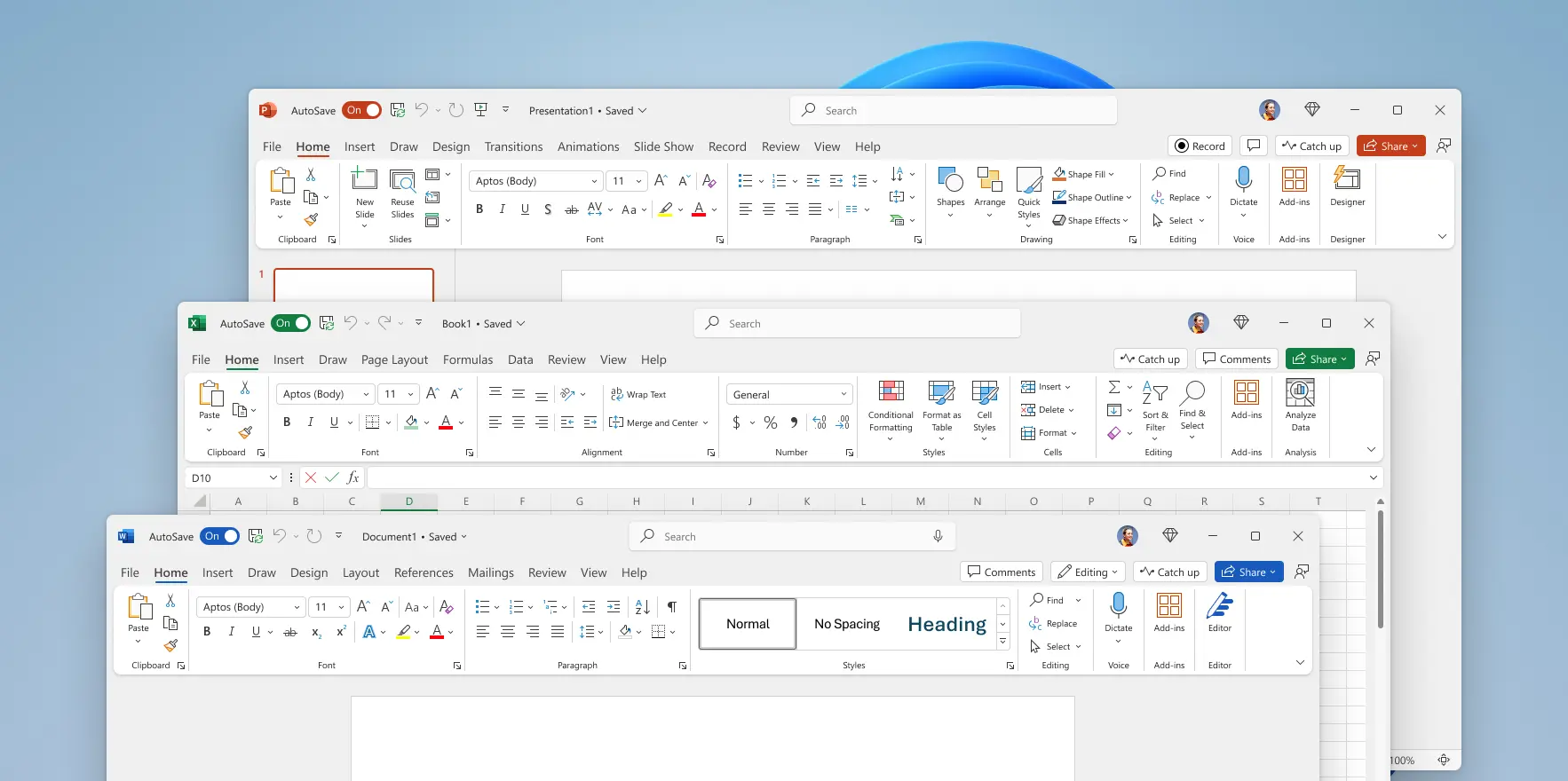Why did UI’s turn from practical to form over function?
E.g. Office 2003 vs Microsoft 365

It’s easy to remember where everything is with a toolbar and menu bar, which allows access to any option in one click and hold move.

Seriously? Big ribbon and massive padding wasting space, as well as the ribbon being clunky to use.
Why did this happen?
Probably so since jackass in a suit could double his annual bonus.
Contrast is Satan to designers, because being able to distinguish the zones of a UI messes with their perfect colour blocking.
Makes me think of people who want to cut down all trees along streets and replace all grass with concrete. So that all would be empty and similar and “in order”.
By the way! I can see how this (color blocking) may resonate with one’s ADHD and the stereotype that many designers have it.
But if any such a designer is reading this, I want them to understand that using their … creations with ADHD is harder, not easier, than using normal, traditional UIs.
For the designer this may be a distracting and irritating contrast, because they have no use for information conveyed by it. For the user it’s the opposite, they are distracted and irritated because of not being able to quickly find what they need.
I bet it’s capitalism.
The answer for enshittification of the entire reality seems to always be
capitalism.
You can use OpenOffice which hasn’t adopted any new UI since 1998.
Except that OpenOffice has been forked into LibreOffice in like 2010 and has since gotten an optional ribbon UI.
There’s been a trend towards simplicity/minimalism in UX for a long time. Sometimes it works really well. Other times it makes it difficult to find things like setting preferences (or they just don’t implement them because the assholes think they know better than you).
For me, MS is a mixed bag. Some of the UX changes are good, some of it is horrible.
But I love a well done minimalist UX. Obsidian and Reaper are two examples that come to mind.
Weirdly as someone who has used both styles heavily, I’d say the ribbon is more practical than the old toolbars. There’s more contextual grouping and more functional given the tabs and search, plus the modern flat design is less distracting, which is what I’d want from a productivity application. Also for me two rows of toolbars & a menu is about the same height as the ribbon anyway, and you can collapse the ribbon if you want to use the space
Flat design may be less distracting to you but that also means it’s less clear, because there are fewer obvious demarcation.
I despise flat design, it’s downright awful design, and done for looks rather than functionality.
Even saying it’s “less distractive” supports this.
Microsoft also did this to obfuscate features, which is pretty apparent when you consider new users used to “discover” features via the menu system. I supported Office for MS in the early days, and this was a huge thing at the time. It was discussed heavily when training on new versions.
How many UI/UX usability studies have you done yourself. Links to results.
Since when is it not okay to have an opinion on how you’d like your computer to work? You’re saying it as if usability was an objective truth, not a preference of majority of users. People are different, everyone is talking about neurodiversity, and you’re saying that loving lowest common denominator UIs are the only acceptable opinion in the light of objective facts.
Flat design may be less distracting to you but that also means it’s less clear, because there are fewer obvious demarcation.
I despise flat design, it’s downright awful design, and done for looks rather than functionality.
to you
Flat design dominates for a reason—the less visually busy something is, the easier it is for users to wrap their heads around it. This gets proven again and again in user studies, the more busy and dense you make things, the more users miss stuff and get lost.
People’s opinions on the ribbon specifically are obviously all subjective, but I would say the less distracting design would be the one done less for looks, rather it’s a pretty utilitarian design if you pick it apart. This is an interface for productivity tools, and as such the interface should get out of your way until you need it—the ribbon just does that better IMO.
Microsoft also did this to obfuscate features, which is pretty apparent when you consider new users used to “discover” features via the menu system. I supported Office for MS in the early days, and this was a huge thing at the time. It was discussed heavily when training on new versions.
Why on earth would Microsoft want to obfuscate features? There’s no way that motivation would ever make sense.
IIRC one of the main reasons Microsoft introduced the ribbon was that grouping functionality contextually helped users discover features, because people kept requesting features that already existed, but they just couldn’t find. I remember there being a blog on the Microsoft developer site about the making of it that went into this.
All that usability testing that Microsoft did is a big part of the problem. Instead of the functionality of functionality being organized under menus by function ….
They made “typical” functions more accessible to “typical” users, but I’m not typical; most people don’t match that average profile. Anyone who uses Office at all frequently are not average users. Anyone who frequently needs a particular functionality are not average users
Instead of being organized under menus by name, it’s now organized under ribbon tabs by icon, visual grouping, and sometimes also name. It’s no less organized lol
Granted the icons are getting better over time, but all too often I’m still looking for the name to figure out what that mysterious icon is. Now I need to adjust the screen size so more names appear so I can figure out what to click. Wouldn’t it be nice if the names were all visible at a click, organized hierarchically?
Why wait for a click? Each ribbon tab has submenus with their contents already visible (no necessary click --> hover/click --> hover in submenu without letting your mouse leave for even 1 pixel) and the state of each option represented in whatever way is most convenient (button, toggle, dropdown, etc.). A menu doesn’t show all options in one category at once, doesn’t fully show their state, and closes itself every time you mess up a mouse movement if it’s programmed badly. The lack of names can be bad, but the learning curve for identifying options (hovering and seeing the name) isn’t worse than it is for finding options in a menu (searching every menu until you find the right option).
Microsoft also did this to obfuscate features
lol
I remember people being upset by the ribbon back when office 2007 was released. Their complaints made sense until I sat down and used it. Found it to be a great improvement. I switched my libre office to the ribbon layout as soon as they added it. Because I don’t use it often, it’s great for finding stuff compared to looking through the menus.
The nice thing about the LO implementation is also that they added a couple of varieties of the design, like the compact one which pushes things closer together so it’s not distracting.
It’s like having a robot vacuum. You’ll catch yourself saying “Why is it ALWAYS getting in my way??!” It’s not, it’s just that you only think about where it is when it’s in your way. When it’s not around you, you are thinking about other things.
UI is the same. People complain about any UI they actually stop to notice. If you know the UI well you don’t even really think about it, you just use it. When a UI changes you have to relearn a little bit and this causes people to have to stop and think about the UI.
99.99% of the time people seem to interpret this as “This UI objectively sucks! Any UI I need to think about must be terrible!”
But it’s not that hard to understand that a little relearning will follow change, and that things will have to change over time unless they were perfect forever out of the box, which nothing is.
But no. “The new update is horrible!” Every. Time. It’s so routine to UI designers that they totally ignore this feedback. So people really shouldn’t even bother to post it.
Yeah, does anyone else remember the menu bars that would show up and disappear depending on what you were doing? Those were awful–the ribbon method of context-specific tabs is better (IMO).
It’s not UI backsliding. It’s Microsoft being incompetent. I have no idea how they’re still in business, and astounded at their valuation. It seems like everything they manage to push out is just barely functioning
They have to maintain backwards compatibility for 40+ year old applications so that they don’t lose big corporate and government customers, but they also have to chase the newest trends in order to keep their shareholders happy. They built their business on selling their software, but most of their competitors are giving functionally-equivalent programs away for free. Their software runs without incident on literally billions of devices for decades, but one or two high-visibility bugs or design missteps and public perception of their brand totally tanks.
And so, their business model sucks. Moving Windows to become a data-harvesting SaaS was a terrible choice, their pivot to AI is going to crash and burn, and rent seeking software subscriptions are a scourge.
But I think they’re just too big and too vertically integrated to actually be any better at this point. I just don’t think it’s possible for their executive team to make good decisions anymore, not because they’re dumb, but because the good decisions literally don’t exist. It’s like a black hole, where the closer you get to the event horizon, the more possible paths point toward the singularity; likewise, the bigger Microsoft gets, the more possible decisions point toward “devastatingly bad.” They honestly should have been split up 25 years ago; for the industry’s sake and for their own.
Moving away from Office and Windows and so forth is a nightmare for any larger company. If you use specialized software, it might very well only run on Windows or only have an integration into Office. Even if you could, you then have to retrain staff to use Libre Office, Linux and other alternatives. You also will have problems converting, changing servers and so forth.
So companies just do not switch. That is how Microsoft makes money. They really do not care that much about private users. That is only usefull so people can use their products.
deleted by creator
I’m ashamed to say I used to work for one. How do you like having licenses to use your printer? I might have enjoyed it even if only I were a sadistic personality type.
I miss 07 jfc…
Funny story, before they did the 2007 redesigns, they asked users what they wanted to be added; 95% said features that were already in Office.
The Ribbon was designed to make features more findable.
Alas.
I’ve used Office 2003, 2007, 2010 etc. all the way up to 365 not for work purposes, but just happened to have interacted with all of the versions.
I have to say, I seriously don’t know what happened, but Office 2003-2007 feels the most stable and least clunky versions of Office (at least Word) in terms of basic word processing.
I learned how to properly edit and format text in Word in university in a way that I could, without fail, reproduce almost any text design you could think of. When I was learning it on Office 2007 I believe, everything was so stable and predictable. Now when somebody asks me to format some text with 365, the styles functionality continually keeps bugging out and doing stupid shit that I basically can’t recover from unless I create a blank file.
In conclusion, Office 2007 > 365
/rant
Am I wrong, or isn’t Office 365 a web app? Not really a 1:1 comparison.
Office no longer exists as it used to. The applications are being turned into offline websites. See Modern Outlook, Modern Teams ect. They are cost cutting all the different app platforms down to one. An offline website for each app.
peak enshitification
No. Microsoft 365 (previously office 365) is not a web app. They have web apps, and some licenses (the bare bones $6/mo one) only has web apps. But overall the suite of apps can’t be defined as web based.
Not to be confusing, but some of the apps are only web apps, but those are “other” apps than you’re probably thinking of. Like Planner or Power Automate. The “office” apps like outlook, word, excel and PowerPoint all have desktop and web versions included.
There’s Office online, which has a free tier and a “365” tier, whatever that means. Does it mean that you have Office available 365 days a year? Good luck on February 29th, I guess. /j
Anyway, Microsoft transitioned Office into a subscription-based model, which I abhor because I just want to have a piece of software without feature updates, just bug and security fixes. So Office 365 is just normal Office, but on a subscription basis.
Not really correct. Microsoft is moving ALL their apps to offline web apps. Modern Outlook and Modern Teams are the first to go.
Modern…
://///
I miss native apps being the norm (and I don’t mean Chromium disguised as a native app).
Same, but for Excel.
Also, JFC the save menu in Office 365 is Cthulhu-level madness.
Can you tell me more about that save menu?
the windows save menu has remained mostly the same since win3. Office products used the regular windows save menu for ages. Then suddenly they introduce a monstrosity that takes up the whole screen and throws decades of useful design out the window. If i describe it further I shall descend into madness
The ribbon is one thing, the flat design and obfuscating tools/settings are a far bigger issue.
I always hated the ribbon context menu system. It ruins the way I learn watch involves where something is just as much as what it’s called, kinda like remember where on a physical page something is even if you don’t remember the page.
Static, nested menus are superior.
I have no problems with it, so I guess I’m some sort of savant? There is such thing as good and bad UI, but I think this is a case of ‘what you’re used to’ causing problems with ‘what is.’
I don’t want to insult your intelligence, but you may just be tech-savvy, or at the very least, tech-literate. I also don’t have a problem with either because I simply follow the UI logic as the average Jane should.
The Ribbon is much better, and has been a part of the Office suite for over a decade, easily.
Poor examples aside, designers and engineers are rarely given a seat at the table in big tech companies. Most tech CEO’s were either tech managers or sales people at some point, and are so far removed from IC work or valuing specific crafts for their user value that someone on the UX side probably doesn’t get a say in how this shit is built.
Some UX designers either work to very specific business constraints, or work on stuff that has zero benefit to the end-user. Some engineers work on stuff that solely provides metrics for shareholders and leadership.
I’m tempted to set up a blog just to post about this subject, because it’s everywhere, but big tech is now so top-heavy that for years many huge decisions have been made on a whim by execs. Tech has grown so large and powerful that tech execs (and those clinging to their coat-tails) put themselves outside of the echelons of what an IC can reach, and far above the user. Years of MBA double-speak and worshipping the altar of guys like Gates, Bezos, and Jobs means that it’s “good” to be opinionated and ignore fact over your own judgement. This results in senior management deciding “let’s put AI here” or “the colour scheme should be mostly white”, despite reluctantly paying hundreds of people many thousands of dollars a year to KNOW about this stuff.
That, in essence, is why everything feels shitter nowadays. It’s because some fifty-something MBA cunt believes that you need AI, or a good UI needs more buttons - stuff we’ve known for decades is fucking stupid. That’s irrelevant though, because by being “General Manager of UI at MegaCorp” and having an assistant to arrange their Outlook calendar, they know more than you, pleb.
Related: https://youtu.be/HdozqSVF-VM
What makes it even worse is that screens got wider and shorter, but the new designs use more vertical space than before, leaving even less height to do anything in.
My $300 32 inch IPS 16:9 monitor laughs hard at my old $2000 19 inch 4:3 CRT.
If you are on a desktop, it’s insane how both cheap and good monitors have become.
Still I absolutely agree, wasting vertical space is more annoying than horizontal.16:9 was pushed on us because it was cheaper to produce on mass for tv and pc. 16:9 was better for movies.
There are some monitors from just before this massive market manipulation and those have 16:10, sometimes with display port before hdmi was even mainstream.
Apple is actually one of the few companies to make the jump from 4:3 to 16:10 avoiding the 16:9 with very few exceptions.
To this day i see people work with old software designed for the area of more vertical screens but doing so on screens designed for movies.
Most people dont even understand what i mean when i explain this. But the good thing is my issue with it was considered a disability so they had to accommodate me with something more sensible.
Sorry long comments but this is a personal vice for me.
I swear I still get letterboxes on a 16:9 television watching at least some movies. And of course I get pillarboxes for days watching “fullscreen” pan & scan DVDs or anything shot for TV before 2010.
16:10 is a pretty good laptop aspect ratio, but on the desktop I don’t think I’m giving up my 21:9 monitor. For gaming it’s simply majestic and having enough real estate for CAD and a spreadsheet open side by side and actually get stuff done is something I won’t give up.
Actually i have and love my 21:9, but it was a weird journey.
The most common resolution for them is 3440x1440 21:9
At work i use a 2560x1600 16:10
You may see my problem, i was not going to give up those 160 vertical pixels. So i got a 3840x1600 instead…
Which comes down to the same 21:9…
I think the reason its not a problem is cause how rarely your only using a single fullscreen window on such ultrawides.
Majestic for gaming ind… and the gpu caught fire again.
my RX7900GRE doesn’t have any issue pushing 1440p ultrawide.
Ha, but the presence of vertical monitors means we can do this , amirite? We’re just better using the screen space people have …. Who have spent hundreds of dollars extra on extra hardware to make this shitty ui usable
I prefer the ribbon. It makes everything easier to discover and use.
It’s also entirely configurable so i was able to tailor it specifically to my needs, even include button for my macro, logically grouped and not thrown together with no heads or tail in a “macro” submenu.
It also allows widgets with much richer informational content than menus.
The ribbon is also entirely keyboard navigable with visual hints. Which means you can use anything mouse free without having to remember rarely used shortcuts.
And if the ribbon takes too much space, and you can’t afford a better screen, you can hide and show it with ctrl-F1 or a click somewhere (probably).
It’s actually a much much better UX than menus and submenus and everything hidden and zero adaptability. At least for tools like the office apps with a bazillion functions.
Most copies of the ribbon are utter shit though because the people who copied didn’t understand the strength of the office ribbon and only copied the looks superficially.
It’s funny to see people still hung up on the ribbon 17 years later.
It’s because of people like you that we still use qwerty on row staggered keyboards from the mechanical typewriter era. ;)









